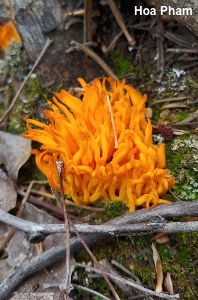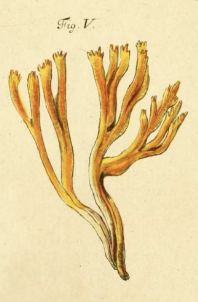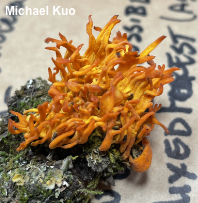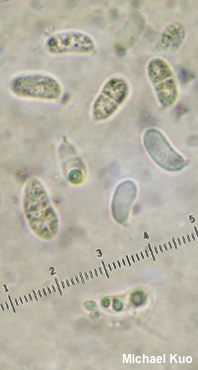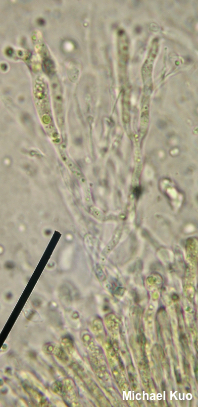| Major Groups > Jelly Fungi / Clubs & Corals > Calocera viscosa |

|
[ Basidiomycota > Dacrymycetales > Dacrymycetaceae > Calocera ... ] Calocera viscosa by Michael Kuo, 30 November 2022 Here's a bright orange jelly fungus that is big enough to be easily mistaken for a club fungus—perhaps something like Clavulinopsis corniculata. However, club fungi like Clavulinopsis corniculata have fragile, brittle flesh, while the flesh of Calocera viscosa is tough and gelatinous. Like most jelly fungi Calocera viscosa grows on wood, but the wood is usually moss-covered and often buried, so that the mushrooms appear terrestrial. In its typical form, Calocera viscosa has branched fruiting bodies that are clustered together and have "cristate" tips that are split several times, looking like the still-emerging antlers of a yearling deer. However, the mushroom can also develop without much branching and without the cristate tips. The collection featured here is one of these "atypical" collections, so I have also illustrated the species with the original, 18th Century illustration (Schaeffer 1763), which does a fine job of depicting the branching and cristate tips. Calocera viscosa can be separated from the similar Calocera cornea by its larger size, and by its growth habit and substrate; the latter species grows gregariously, but not in clusters, directly from the visible deadwood of hardwoods, usually on sticks or small logs. Additionally Calocera cornea has smaller, yellower fruiting bodies that turn reddish brown when dried for the herbarium, while the fruiting bodies of Calocera viscosa remain orange to yellow when dried. Thanks to Hoa Pham for documenting, collecting, and preserving Calocera viscosa for study; her collection is deposited in The Herbarium of Michael Kuo. Description: Ecology: Saprobic; growing in troops and clusters on the moss-covered deadwood of conifers (often on buried wood, and appearing terrestrial); summer and fall, or over winter in warm climates; originally described from Germany (Schaeffer 1763); widely distributed in Eurasia and North America. The illustrated and described collection is from Colorado. Fruiting Body: A cluster of individually discrete cylinders up to about 8 cm high and 4 mm thick; cylinders usually branched two or more times, with "cristate" tips that split several times—but sometimes individual cylinders are essentially unbranched and feature single, pointed tips. Surfaces orange to orange-yellow when fresh; bald; lubricous when fresh but soon dry. Flesh: Tough and gelatinous; orange. Odor: Not distinctive. Microscopic Features: Spores 9–12 x 3.5–5 µm; allantoid; smooth; 0–1-septate; hyaline in KOH; at maturioty beginning to germinate with small, ellipsoid conidia. Basidia and probasidia becoming Y-shaped; 25–70 x 3–4 µm; yellow to golden in KOH. Hyphae of the context 2–4 µm wide; septate; branching occasionally; smooth; thin-walled; hyaline to yellow in KOK; clamp connections not found. REFERENCES: (C. H. Persoon, 1794) E. M. Fries, 1827. (Brasfield, 1938; Martin, 1952; McNabb, 1965; Lowy, 1971; Reid, 1974; Phillips, 1981; Smith, Smith & Weber, 1981; Arora, 1986; Breitenbach & Kränzlin, 1986; Lincoff, 1992; Barron, 1999; Shirouzu et al., 2009; Trudell & Ammirati, 2009; Buczacki et al., 2013; Shirouzu et al., 2013; Siegel & Schwarz, 2016; Castro-Santuiste et al., 2017; Gminder & Böhning, 2017; Kibby, 2017; Læssøe & Petersen, 2019; Zamora & Ekman, 2020; Fan et al., 2021; MacKinnon & Luther, 2021; McKnight et al., 2021.) Herb. Kuo 08312201. This site contains no information about the edibility or toxicity of mushrooms. |
© MushroomExpert.Com |
|
Cite this page as: Kuo, M. (2022, November). Calocera viscosa. Retrieved from the MushroomExpert.Com Web site: http://www.mushroomexpert.com/calocera_viscosa.html |
